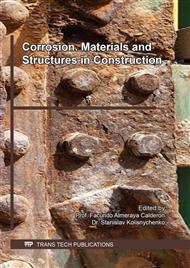[1]
А.А. Chikichev, S.А. Belykh, А.I. Kudyakov, Hydrophobic-fungicidal admixture and dry plaster mix on its basis, Bulletin of MSUCE, Vol. 12. 6 (105) 661-668.
DOI: 10.22227/1997-0935.2017.6.661-668
Google Scholar
[2]
L.Yu. Ogrel, V.I. Pavlenko, М.М. Kosukhin, I.V. Shapovalov, Bioresistant cement concretes with polyfunctional modifiers, Building materials. 11 (2003) 48-49.
Google Scholar
[3]
V.F. Smirnov, А.V. Dergunova, Е.V. Zavalitin, Improving the bioresistance of building materials and products by means of their porous structure impregnation, News of KazSACU. 2 (14) (2010) 218-222.
Google Scholar
[4]
M. M. Kosukhin, A. M. Kosukhin, K. S. Komarova, Increasing of the energy efficiency in civilian buildings applying fixed type of facade systems, International Conference on Energy Systems-2007 (ICES 2017), Journal of Physics: Conf. Series. 1066 (2018) 012012.
DOI: 10.1088/1742-6596/1066/1/012012
Google Scholar
[5]
K.V. Sazanova, I.L. Kuzikova, N.G. Medvedeva, The influence of fungicides on the production of acids by fungi of Aspergillus and Penicillium genera, Mycology and phytopathology, Vol. 50. 2 (2016) 124-129.
Google Scholar
[6]
Е.N. Goncharova, М.М. Kosukhin, О.S. Belolapotkova, S.V. Tkachenko, Research of bioresistance of concretes, in: Ecology – education, science and industry: Collection of research papers of International research and methodological conference, BelSTABM, Belgorod, (2002) 137-141.
Google Scholar
[7]
I.V. Shapovalov, L.Yu. Ogrel, М.М. Kosukhin, Fungicidal modifier of mineral building compositions, in: Problems and ways of creating composite materials and technologies on the basis of secondary mineral resources: Collection of research papers of Research and practice seminar, SibSIU, Novokuznetsk, (2003) 242-246.
Google Scholar
[8]
M.M. Kosukhin, I.V. Starostina, A.M. Kosukhin, Reclamation of chemical wastes for the production of efficient concrete modifiers, International Journal of Engineering and Technology (UAE). 7(2) (2018) 34-37.
Google Scholar
[9]
М.М. Kosukhin, N.А. Shapovalov, А.М. Kosukhin, А.А. Babin, Superplasticizer for concretes based on light pyrolysis resin, Building materials. 7 (2008) 44.
Google Scholar
[10]
V.А. Poluektova, М.М. Kosukhin, V.М. Malinovker, N.А. Shapovalov, Polyfunctional super-plasticizer for concretes based on pyrocatechin production waste, Fundamental research. 1 (2013) 718-722.
Google Scholar
[11]
N.А. Shapovalov, А.А. Slyusar, М.М. Kosukhin, О.V. Mukhachev, Superplasticizer SB-5 as a modifier for obtaining low water demand binders and concretes on their basis, Concrete and reinforced concrete. 6 (2001) 2-4.
Google Scholar
[12]
М.M. Kosukhin, N.A. Shapovalov, A.M. Kosukhin, Colloid-Chemical Bases on Creation of Multifunctional Modifiers of Concrete Mix and Concrete, in: Solid State Phenomena, Vol. 265, Trans Tech Publications, Switzerland, (2017) 331-336.
DOI: 10.4028/www.scientific.net/ssp.265.331
Google Scholar
[13]
GOST 9.048 – 91 Methods of laboratory tests for mould resistance.
Google Scholar
[14]
А.V. Ferronskaya, V.P. Tokareva, Improving bioresistance of concretes based on gypsum binders, Building materials. 4 (1992) 18-20.
Google Scholar
[15]
Е.I. Andreyuk, V.I. Bilay, E.Z. Koval, Microbial corrosion and its causative agents, Naukova Dumka, Kyiv, (1980).
Google Scholar
[16]
Recommendations for hydraulic concretes production with biocidal admixtures, CRCRI, Moscow, (1981).
Google Scholar
[17]
Yu.V. Denisova, А.V. Popova, М.М, Kosukhin, N.А. Shapovalov, The influence of fungicidal PFM on biodeterioration processes in cement concretes, in: Problems and achievements of building materials science: Book of reports of International research and practice online conference, BSTU named after V.G. Shukhov, Belgorod, (2005) 41-43.
Google Scholar
[18]
I.V. Shapovalov, L.Yu. Ogrel, М.М. Kosukhin, Improving fungi-resistance of wood-filler cement composites, in: Ecology – education, science and industry: Collection of research papers of International research and methodological conference, BelSTABM, Belgorod, (2002) 271-273.
Google Scholar
[19]
М.М. Kosukhin, N.А. Shapovalov, V.А. Lomachenko, Modified bioresistant concretes for hot and humid climate conditions, Proceedings of Higher Educational Institutions: Construction. 5 (2005) 46-48.
Google Scholar
[20]
М.М. Kosukhin, А.М. Kosukhin, The mechanism of action of a polyfunctional modifier made of hydrocarbons production waste in mineral suspensions based on fine-ground cements, in: Solid State Phenomena, Vol. 284, Trans Tech Publications, Switzerland, 2018, pp.885-892.
DOI: 10.4028/www.scientific.net/ssp.284.885
Google Scholar
[21]
М.М. Kosukhin, А.М. Kosukhin, N.А. Shapovalov, Composite binder for highly cold-resistant road concretes, Bulletin of BSTU named after V.G. Shukhov. 1 (2010) 51–53.
Google Scholar



